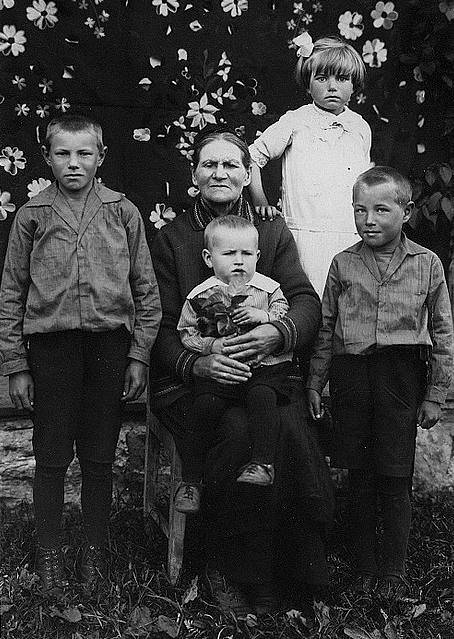
Estonian Families

Figure 1.- We note a mother, or probably the grandmother, with her four children in what looks liike a portrait taken by an itinerant photographer. We are not sure if the back drop is mother displaying here sewing skills or one brought by the photographer. The portrait is not date, but looks like the 1920s to us. The child in white with the bobbed hair is presumably the daughter of the family. She looks to be about 5-years old. The three boys atre presumably brothers. The look to be about 1-10 years of age. The older boys seem to be dressed very much alike--with the same kind of dark open shirts. They wear knee pants and black long stockings. The boys have very short cropped hair. This was very common in the Baltics as they were influenced by both Germany and Russia. -
|
|
We have little information on Estonian families at this time. Estonia is a very small country. And our archive is limited. These family portaits are very useful because they show how the different menbers of the family were dressed at various times. We have managed to find a few Estonian family images. We note a mother with her four children in what looks liike a portrait taken by an itinerant photographer. Typical dress for a middle-class family during the era of independent Estonia can be seen here (figure 1). We have some information about the Tomasson family which the Soviets deported in 1941. We have information on another family, that of Captain Uno Kangur who was the captain of a Baltic fishing boat. The information comes from 1972 when Estonia was still a part of the Soviet Union.
Mother and Children (1920s)
We note a mother, or probably the grandmother, with her four children in what looks liike a portrait taken by an itinerant photographer. We are not sure if the back drop is mother displaying here sewing skills or one brought by the photographer. The portrait is not date, but looks like the 1920s to us. The child in white with the bobbed hair is presumably the daughter of the family. She looks to be about 5-years old. The three boys atre presumably brothers. The look to be about 1-10 years of age. The older boys seem to be dressed very much alike--with the same kind of dark open shirts. They wear knee pants and black long stockings. The boys have very short cropped hair. This was very common in the Baltics as they were influenced by both Germany and Russia.
Middle-class Family (1930s)
Typical dress for a middle-class family during the era of independent Estonia can be seen on the previous page. This the family of Karl Eduard Sööt Villem Grünthal. I believe that he was an Estonian writer. The photograph was taken in July 1939 a few weeks before the NAZI invasion of Poland and the Soviets began to take over Estonia. I do not know what happened to the family after the Soviets took over the country.
Here we see two generations of the Tomasson family. They are left to right: Milvi Tomasson, grandfather Jaan Tuum, and Uuno Tomason, The photograph was taken in Tallinn during 1937. Here we see two generations of the Tomasson family. They are left to right: Milvi Tomasson, grandfather Jaan Tuum, and Uuno Tomason, The photograph was taken in Tallinn during 1937. We do not know much about the family, but by the way they were dressed, they look like they are members of a prosperous middle class family. Clearly it was a chilly day since all are wearing overcoats. Milvi wears what looks like a dressy velvet double-breasted overcoat with a generous collar. She seems to be wearing a matching hat. Although independent for almost 20 years, the Soviets continued to see Estonia and the other Baltic Republics as lost provinces of Russia. After the Soviet occupation (1940), Stalin had large numbers of Estonians deported.
We have little information on Estonian families at this time. We do have information on one family, that of Captain Uno Kangur who was the captain of a Baltic fishing boat. I believe that the family was of Estonian and not Russian extraction. The information comes from 1972 when Estonia was still a part of the Soviet Union. Captain Uno Kangur was I believe of Estonian extraction, not Russian. He was the skipper of a Soviet fishing trawler. The skipper is Captain Uno Kangur who commands a small vessel that traverses much of the Baltic Sea in search of commercial catches of fish.
HBC

Related Chronolgy Pages in the Boys' Historical Web Site
[The 1880s]
[The 1890s]
[The 1900s]
[The 1910s]
[The 1920s]
[The 1930s]
[The 1940s]
[The 1930s]
[The 1940s]
[The 1950s]
[The 1960s]
[The 1970s]
[The 1980s]
Related Style Pages in the Boys' Historical Web Site
[Smocks]
[Long pants suits]
[Knicker suits]
[Short pants suits]
[Socks]
[Eton suits]
[Jacket and trousers]
[Trouser suspension]
[Blazer]
[School sandals]
[School smocks]
[Sailor suits]
[Pinafores]
[Long stockings]
Navigate the Boys' Historical Clothing Web Page
[Return to the Main Estonian country page]
[Introduction]
[Activities]
[Biographies]
[Chronology]
[Clothing styles]
[Countries]
[Bibliographies]
[Contributions]
[FAQs]
[Spanish glossaries]
[Satellite sites]
[Tools]
[Boys' Clothing Home]
Created: 9:41 PM 7/3/2011
Last updated: 9:41 PM 7/3/2011



